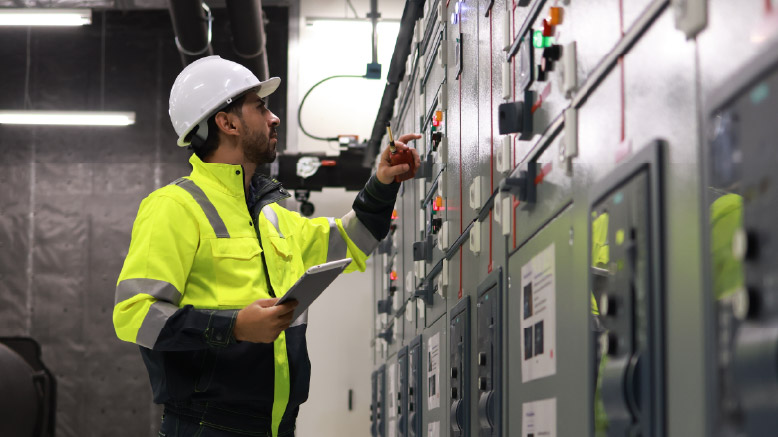— 5 min read
Retrofitting Aging Infrastructure: 5 Essentials for Managing MEP Risk


Last Updated Aug 6, 2025

Ian Goduti
Principal Strategic Product Consultant, Specialty Contractors
Ian Goduti is a well-rounded construction leader, highly skilled in several core areas of this fast-paced industry. He has over a decade of project management experience, overseeing several complex, high-profile projects for major clients including Boeing, the Salt Lake City Airport, St. Regis resort, and the University of Utah. A graduate of the University of Utah where he holds a degree in Environmental Science, Ian is committed to servicing customers in a manner that satisfies their unique needs while furthering the construction space.

Diane McCormick
Writer
49 articles
Diane McCormick is a freelance journalist covering construction, packaging, manufacturing, natural gas distribution, and waste oil recycling. A proud resident of Harrisburg, PA, Diane is well-versed in several types of digital and print media. Recognized as one of the premier voices in her region, she was recognized as the Keystone Media Freelance Journalist of the Year in 2022 and again in 2023.
Last Updated Aug 6, 2025

MEP contractors help preserve aging infrastructure by bringing systems to contemporary standards in sustainability, comfort and accessibility. Although the opportunities are unique, retrofits of existing buildings present known obstacles and unknown surprises that heighten risk and strain efficiencies.
This article explores the challenges of retrofitting aging infrastructure — and five essentials for MEP contractors to address them.
Table of contents
Challenges of Aging Infrastructure Projects
No one is likely to find an actual skeleton in the closet, but aging infrastructure’s unique challenges to scope, schedule, budget and safety include:
- Lack of original plans for reference
- Years of jerry-rigged, undocumented alterations
- Hazardous materials in the walls and the systems
- Rigid constraints from existing walls, floors, ceilings and stairs
- Working around existing features to be preserved in place or removed — carefully — for repurposing.
- Leaky building envelopes that counteract energy-efficient heating and cooling
Systematic application of five essentials helps MEP contractors anticipate and mitigate the risks.
1. Write airtight contracts.
In jobs where significant changes are inevitable, MEPs are especially vulnerable to eating the costs foisted on them.
On retrofit jobs, the key to managing and preventing risk is knowing the possible obstacles present with all aging infrastructure and with those inherent to the building’s specific age and type.
There's a lot there that you don't know. It's not a clean slate, so you almost have to have preconstruction and construction planning while you're actually budgeting or bidding the project.

Ian Goduti
Principal Strategic Product Consultant, Specialty Contractors
Procore Technologies
Under these circumstances, contract provisions should clarify the contractor’s scope, specifying acceptable tasks and the parties responsible for delays or costs incurred. Contingency entries in the schedule and budget should anticipate slowdowns and unplanned spending.
There's a lot there that you don't know. It's not a clean slate, so you almost have to have preconstruction and construction planning while you're actually budgeting or bidding the project.
Risk awareness and clarification continue in the design phase. For instance, a midcentury air base is almost certain to have asbestos, but how much and where can’t be known until the work begins. Discussion should consider the variances and possibilities, ranking them according to highest risk and probability.
In planning and construction, preserving historic features can impact cost, safety and scheduling. Focused design discussions, which linger into construction much more than is typical for new projects, help prevent delays or errors.
For two reasons, contractors should apprise workers of which architectural pieces and finishes are slated for preservation.
The first consideration is safety — preventing accidents caused by working with unfamiliar materials or dislodging unstable elements.
The second is reuse. Designers often differentiate their projects by repurposing its unique aspects, so carelessness that damages or discards them will trigger consequences.
Build a Strong Foundation with our Preconstruction Course
With 20+ years of experience, Ben Ashburn teaches you how to streamline planning, bidding, and procurement for better outcomes.

2. Leverage technology.
In existing structures, MEP work usually begins with electrical and the building’s power needs and any reusable elements. That assessment sets the stage for mechanical to size equipment and build out the design.
3D scanning facilitates early design and planning by modeling spaces as they exist — with all their nooks, crannies and alterations. Integrated into a Building Information Modeling (BIM) platform, detailed scans enable clash detection among installations planned around immovable elements.
Precision models also provide the confidence needed to greenlight the efficient, cost-saving prefabrication of equipment meant to fit into existing spaces.
3. Properly manage specialty work.
Older facilities — especially institutional or governmental — are almost certainly likely to harbor asbestos and other hazardous materials. When they’re encountered, today’s GCs and MEP contractors call the experts.
Specialty hazmat contractors have the equipment, materials, knowledge and people trained to take on the risks of an earlier age.
Similarly, specialty demolition contractors can deftly raze sections of the project without damaging those slated for preservation.
In any case, partnering with specialists helps mitigate risk by preventing damage done by unqualified workers, protecting workers from hazards and accidents and safeguarding the good safety ratings that owners and GCs check on future bids.
MEP contractors who subcontract specialized contractors — which GC’s often prefer — are 100 percent responsible for budgeting, scheduling and all other aspects of the work.
When specialists are under the GC, MEP teams remain responsible for establishing protocols for communications and collaboration, setting expectations and sticking to timelines.
4. Anticipate design and controls.
Projects blending old and new walk a fine line between yesterday’s irreplaceable features and today’s expectations for occupant comfort and energy efficiency.
When design teams develop specifications for MEP contractors to manage, they are taking into account:
- The building’s structural capacity, especially when determining where to locate heavy systems
- Higher power consumption needs than the building was meant to manage
- Routing that snakes through existing walls, floors and ceilings
- Aesthetically aligning today’s equipment and digital devices with the building’s historical features
Owners also expect system customization and energy efficiency. To meet those needs, advanced controls deliver pinpoint automation and systems management.
Often, MEP contractors subcontract the controls team because controls can integrate with mechanical, electrical and plumbing. Those arrangements bring additional risk to MEP contractors over the operational efficiencies of the controls, the building’s energy consumption — and even possible schedule delays.
Unlike traditional MEP installs, tracking progress on controls is elusive. Much of the work is performed on computers that don’t provide visible evidence of whether a task has been completed or is on track.
5. Offer maintenance contracts.
After commissioning, many MEP contractors offer ongoing maintenance contracts — a wise practice for aging infrastructure. They generate revenue while positioning MEP contractors to properly service the new systems they installed in quirky older buildings.
These contracts can prevent calls to fix problems created by a third party’s mismanagement. As they document their work, contractors create maintenance histories that help minimize confusion and accelerate solutions when problems arise.
Working in aging infrastructure has its challenges, but MEP contractors who carefully tread the risks can experience the satisfaction of bringing new life to old buildings and crafting 21st-century-ready projects from the gems of the past.
Managing Retrofits While Managing Risk
Working in aging infrastructure has its challenges, but MEP contractors who carefully tread the risks can experience the satisfaction of bringing new life to old buildings and crafting 21st-century-ready projects from the gems of the past.
The strategic application of airtight contracts, advanced technology, specialized expertise, thorough design planning and ongoing maintenance can significantly mitigate risks and streamline the retrofitting process. This way, the historic elements of older structures are not only preserved but enhanced to meet modern standards of efficiency and comfort.
Was this article helpful?
Thank you for your submission.
0%
0%
You voted that this article was . Was this a mistake? If so, change your vote
Scroll less, learn more about construction.
Subscribe to The Blueprint, Procore’s construction newsletter, to get content from industry experts delivered straight to your inbox.
By clicking this button, you agree to our Privacy Notice and Terms of Service.
Thank you!
You’re signed up to receive The Blueprint newsletter from Procore. You can unsubscribe at any time.
Categories:
Written by

Ian Goduti
Principal Strategic Product Consultant, Specialty Contractors | Procore Technologies
Ian Goduti is a well-rounded construction leader, highly skilled in several core areas of this fast-paced industry. He has over a decade of project management experience, overseeing several complex, high-profile projects for major clients including Boeing, the Salt Lake City Airport, St. Regis resort, and the University of Utah. A graduate of the University of Utah where he holds a degree in Environmental Science, Ian is committed to servicing customers in a manner that satisfies their unique needs while furthering the construction space.
View profile
Diane McCormick
Writer | Procore Technologies
49 articles
Diane McCormick is a freelance journalist covering construction, packaging, manufacturing, natural gas distribution, and waste oil recycling. A proud resident of Harrisburg, PA, Diane is well-versed in several types of digital and print media. Recognized as one of the premier voices in her region, she was recognized as the Keystone Media Freelance Journalist of the Year in 2022 and again in 2023.
View profileExplore more helpful resources

Low-voltage Systems: A New Frontier for MEP Contractors
From design through commissioning, low-voltage system designers and the MEP trades are colleagues. They work together to provide the systems that make buildings safe, connected, comfortable, efficient and equipped for...

Comfort Mood: Making MEP Central to Occupant Comfort
In many post-COVID-19 projects, occupant comfort has transitioned from a “nice to have” to a “must have.” It’s infused into collaborations from the earliest phases of design and preconstruction. That...

The MEP Lifecycle: How Contractors Can Benefit from Thinking Ahead
From the beginning of a project, MEP contractors should be thinking about the lifecycle of their systems. Prioritizing the lifecycle early in the process helps MEP trades influence design, select...

The Top 5 MEP Challenges of Data Centers
Data centers are unique builds that come with unique challenges. MEP contractors stepping up to build data centers are sure to encounter the complexity of systems and the demands of scalability,...
Free Tools
Calculators
Use our calculators to estimate the cost of construction materials for your next project.
Templates
Find a template to help you with your construction project tasks.
Material Price Tracker
Get the latest U.S. retail prices and view historical trends for common building materials.
Glossary
Explore key terms and phrases used in the industry.
